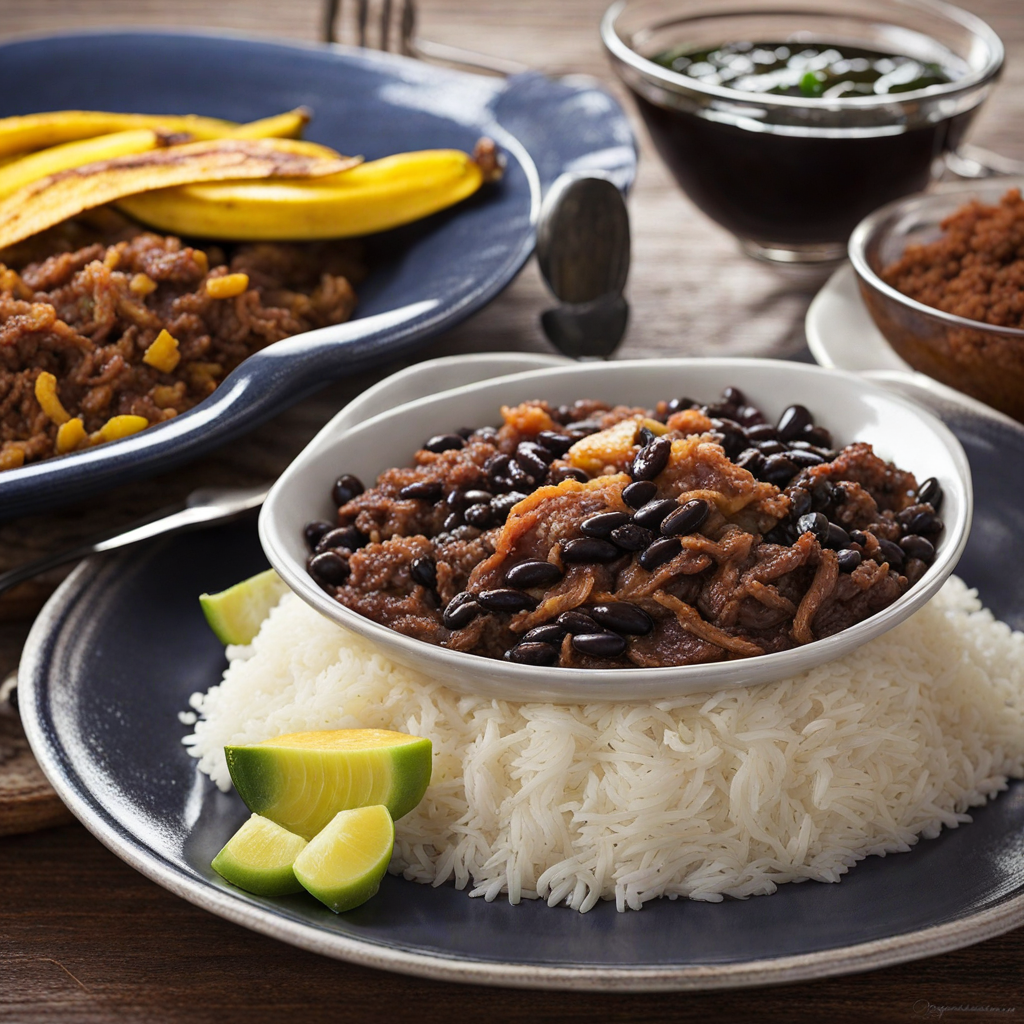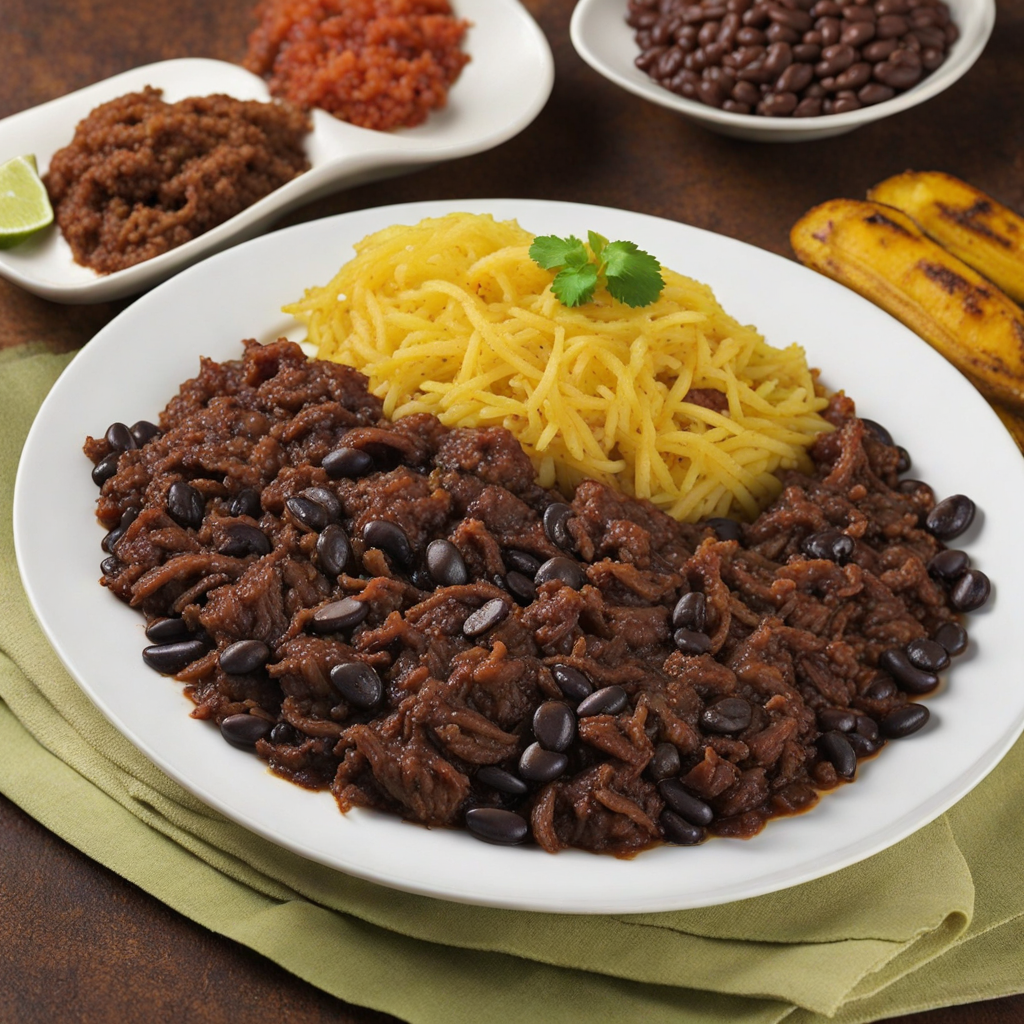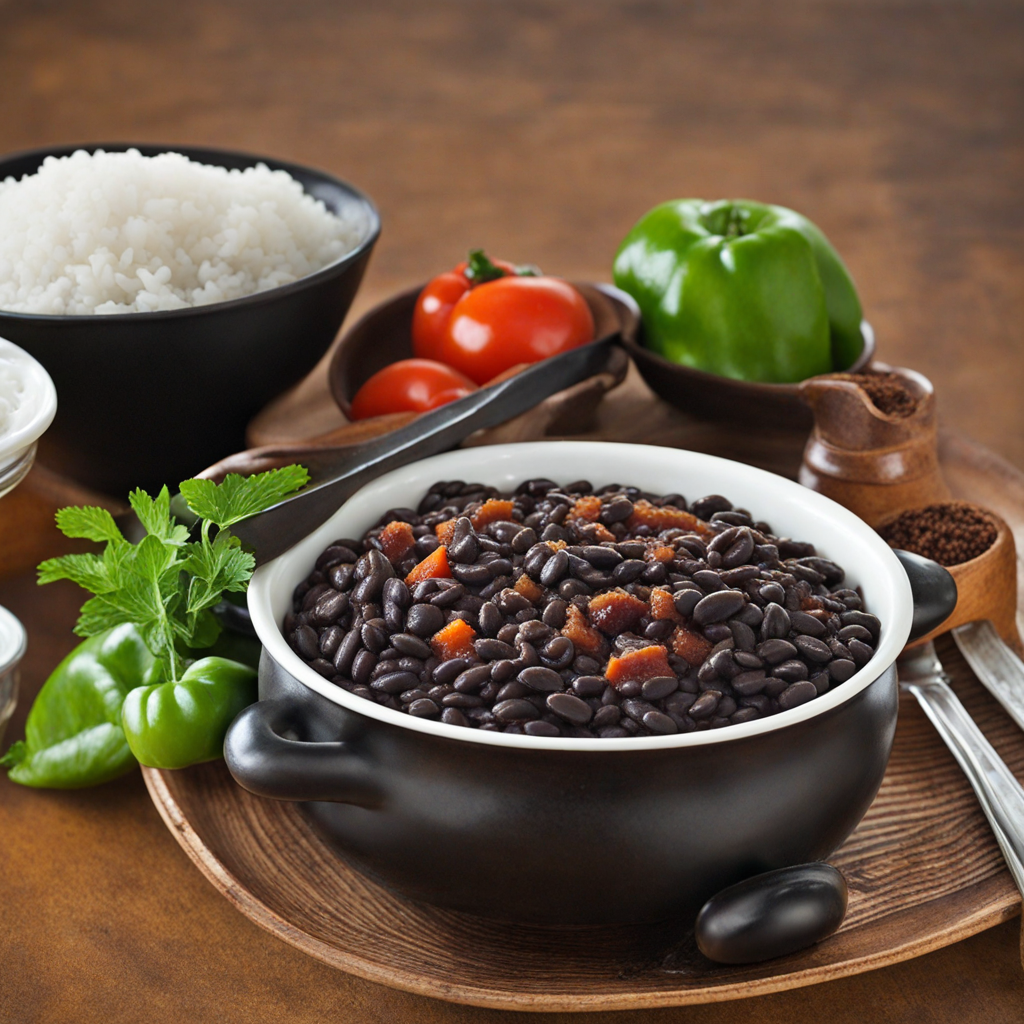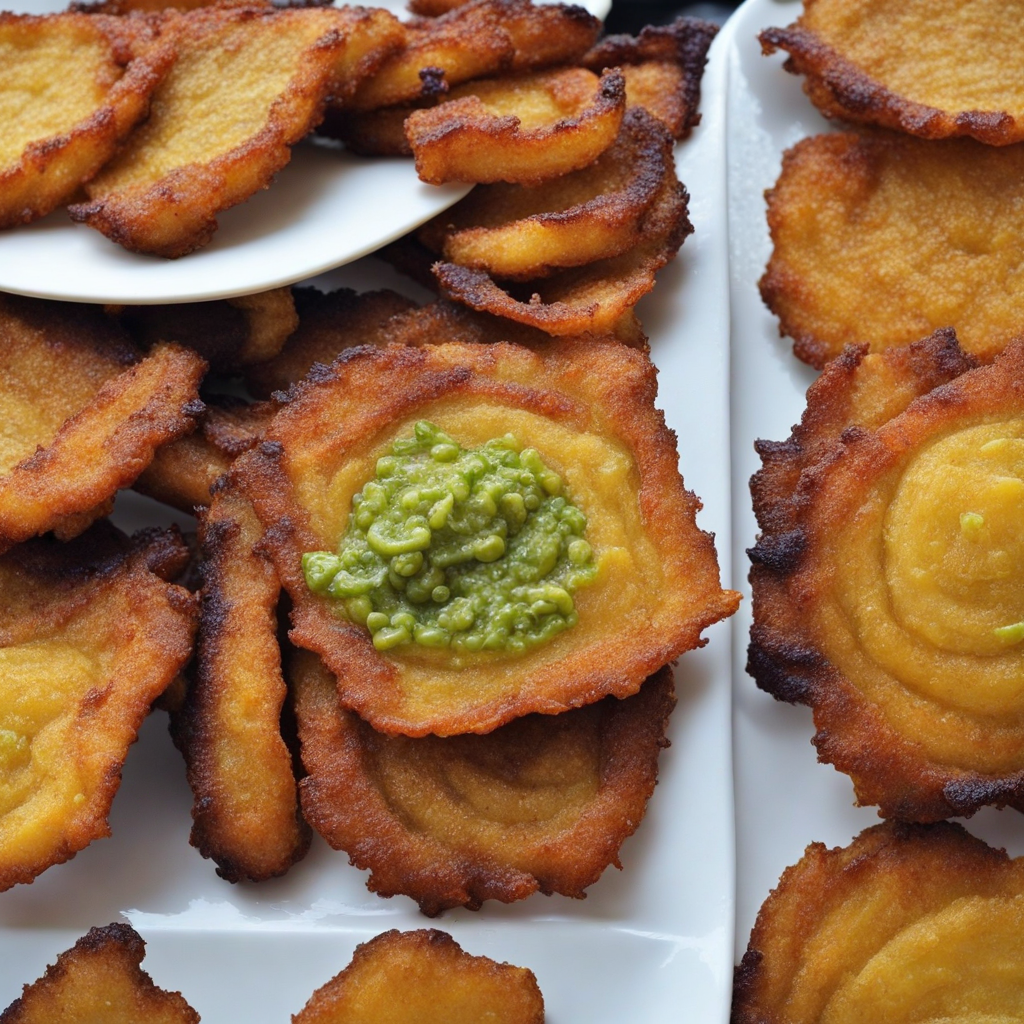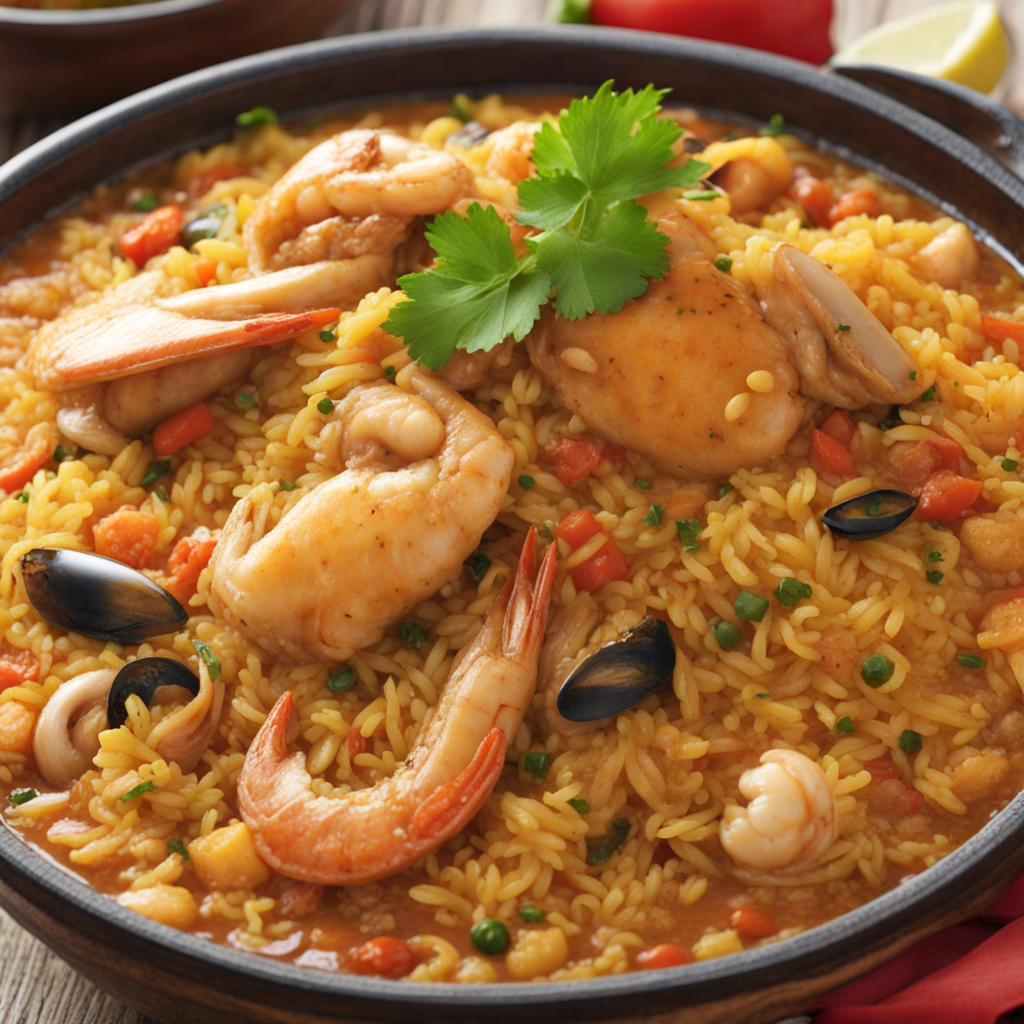Pabellón Criollo
Pabellón Criollo is a traditional Venezuelan dish that beautifully showcases the country’s rich culinary heritage. At its core, this vibrant plate consists of shredded beef, which is slow-cooked until it’s tender and infused with flavors of spices and a hint of sweetness. The beef is often sautéed with onions, bell peppers, and garlic, creating a savory base that is both comforting and hearty. Accompanying the beef are black beans, seasoned to perfection, which add a creamy texture and a depth of flavor that complements the meat beautifully. One of the standout features of Pabellón Criollo is its colorful presentation, typically served with a side of white rice that acts as a neutral canvas for the bold flavors. The dish is often garnished with fried plantains, adding a touch of sweetness and a crispy texture that contrasts with the tender beef and creamy beans. Together, these elements create a harmonious balance of flavors and textures that are signature to Venezuelan cuisine. Pabellón Criollo not only delights the palate but also serves as a cultural symbol, representing the diverse influences that shape Venezuelan food. Each bite tells a story, reflecting the country’s history and its fusion of indigenous, African, and Spanish culinary traditions. This dish is often enjoyed during family gatherings and celebrations, making it not just a meal but a cherished experience that brings people together over the shared love of food.
How It Became This Dish
The Rich Tapestry of Pabellón Criollo: Venezuela’s National Dish #### Origins Pabellón Criollo, often heralded as the national dish of Venezuela, is a culinary masterpiece that encapsulates the country's rich history, cultural diversity, and agricultural bounty. This dish, characterized by its vibrant presentation of black beans, shredded beef, fried plantains, and a generous serving of rice, is more than just a meal; it is a symbol of Venezuelan identity. The origins of Pabellón Criollo can be traced back to the colonial era, where the fusion of Indigenous, African, and European influences laid the groundwork for what would become a staple of Venezuelan cuisine. The use of ingredients such as beans and plantains reflects the Indigenous population's agricultural practices, while the method of cooking meats and the incorporation of spices and flavors showcase the impact of Spanish colonialism. The African influence is particularly significant, as enslaved Africans brought to Venezuela contributed a variety of cooking techniques and ingredients, including okra and the beloved plantains. The name "Pabellón Criollo" translates to "Creole Pavilion," which pays homage to the Creole culture that emerged from the intermingling of these diverse groups. The term "criollo" refers to the descendants of Europeans born in the Americas, and in the context of food, it denotes a culinary style that is distinctly local yet influenced by external traditions. #### Cultural Significance Pabellón Criollo holds a special place in the hearts of Venezuelans. It is not just a dish served at everyday meals; it is a cornerstone of national identity and cultural pride. Traditionally, it is served on Sundays and at family gatherings, embodying the spirit of community and togetherness. The preparation and sharing of this dish resonate with the Venezuelan emphasis on familial bonds and hospitality. Moreover, Pabellón Criollo is often seen as a representation of Venezuela's socio-political history. The dish's components reflect the country’s agricultural resources and the social dynamics of its people. The black beans, a staple in many Latin American diets, symbolize the rich agricultural heritage of Venezuela, particularly in the fertile plains known as the "llanos." The shredded beef, commonly referred to as "carne mechada," features the use of flank steak, a cut of meat that has become synonymous with Venezuelan cooking. In times of political and economic strife, Pabellón Criollo has served as a source of comfort and a reminder of resilience. It is a dish that brings together families and communities, serving as a bastion of tradition in the face of adversity. Venezuelans abroad often find solace in preparing and sharing Pabellón Criollo, connecting them to their roots and offering a taste of home. #### Development Over Time As Venezuela evolved through the 19th and 20th centuries, so too did Pabellón Criollo. The advent of new cooking methods and the availability of different ingredients allowed for variations and adaptations of the dish. While the classic version remains the most revered, modern interpretations have emerged, incorporating elements from international cuisines and catering to contemporary dietary preferences. The introduction of rice as a staple component of Pabellón Criollo is a notable development. In the early days, the dish was often served with arepas or accompanied by yuca (cassava). However, as rice became more widely cultivated and accessible, it gradually replaced other accompaniments. This shift not only reflects changes in agricultural practices but also aligns with the growing influence of rice as a dietary staple across Latin America. In urban areas, where culinary experimentation flourished, variations of Pabellón Criollo began to emerge. Some chefs started incorporating additional elements such as avocado, fried eggs, or even spicy sauces, showcasing the dish's adaptability and the evolving palate of the Venezuelan people. The rise of gourmet Venezuelan restaurants has also led to a renaissance of traditional dishes, with chefs reinterpreting Pabellón Criollo to create elevated dining experiences while honoring its roots. The dish's presentation has evolved as well. While the traditional serving style is straightforward, modern presentations can be visually stunning, often incorporating artistic plating techniques that highlight the vibrant colors and textures of the ingredients. This evolution reflects broader trends in the culinary world, where aesthetics play a significant role in the dining experience. #### Global Recognition In recent years, Pabellón Criollo has gained international recognition, becoming a popular ambassador for Venezuelan cuisine. As Venezuelan communities have spread around the globe due to migration, so too has the appreciation for their culinary traditions. Food festivals, cultural events, and social media have all contributed to the global awareness of Pabellón Criollo, allowing it to find a place on menus far beyond Venezuela’s borders. The dish has also become a focal point for discussions about food security and sustainability, particularly in the context of Venezuela's complex socio-economic issues. The ingredients of Pabellón Criollo, particularly beans and plantains, are emblematic of sustainable agricultural practices, as they are nutrient-rich and can be cultivated in various conditions. Advocates for food sovereignty often cite Pabellón Criollo as a model for promoting local agriculture and preserving culinary traditions. #### Conclusion Pabellón Criollo is a dish steeped in history, culture, and resilience. It represents the fusion of Indigenous, African, and European influences that define Venezuelan identity. As it continues to evolve, both in Venezuela and abroad, Pabellón Criollo remains a powerful symbol of community, tradition, and the enduring spirit of the Venezuelan people. Whether enjoyed in a family kitchen or a fine dining restaurant, this dish serves as a delicious reminder of the rich tapestry of flavors and stories that form the heart of Venezuela’s culinary heritage.
You may like
Discover local flavors from Venezuela


